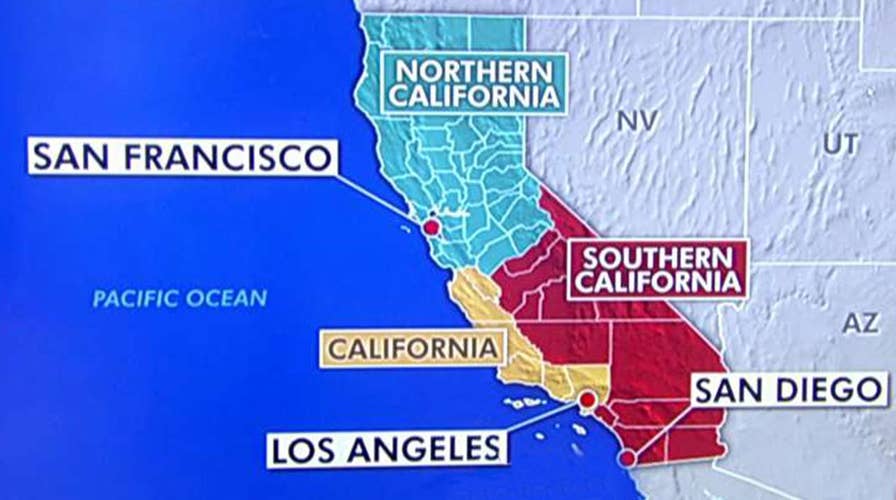Twenty-four states, including California, allow voters to change laws on their own by collecting signatures and putting initiatives on the ballot. The entrenched political class in each of those states faces some real legislative competition from the people at the ballot box.
Unfortunately, some special interests have declared war on the initiative process, using tactics ranging from restrictive laws to judicial strong-arming.
The latest example is from California, where the state Supreme Court issued a ruling Wednesday that blocked an initiative asking voters if they wanted to split their state of almost 40 million people into three separate states.
This was the equivalent of having a British court declare that the 2016 Brexit referendum ending the United Kingdom’s membership in the European Union couldn’t appear before voters.
The legal excuse was that the California Supreme Court had to have further time to study whether the initiative violated the state constitution.
The court ordered California Secretary of State Alex Padilla to throw the measure off the November ballot “because significant questions have been raised regarding the proposition’s validity, and because we conclude that the potential harm in permitting the measure to remain on the ballot outweighs the potential harm in delaying the proposition to a future election.”
The real reason for the court’s action is that it doesn’t really trust the people to weigh in on such a disruptive idea.
But despite the long odds of the measure passing – much less ever securing the necessary approval from the U.S. Congress – over 600,000 people signed petitions asking that the voters be consulted on the idea. Proponents believe that arbitrary political boundaries established many decades ago shouldn’t curb our imagination and prevent creative solutions to our problems.
Efforts to divide California into more manageable and homogeneous parts are as old as the Bear Flag that was raised over the state Capitol at statehood in 1850.
When I was a legislative staffer in Sacramento in 1980, a state assemblyman named Stan Statham had a serious proposal that attracted bipartisan support. He recognized that California’s people would be better served if its competing constituencies had more in common. But his idea went nowhere during the boom years of the 1980s.
Today’s opponents of splitting California are led by the Planning and Conservation League, an environmental lobby. They argue the idea would put cherished environmental laws at risk.
But the main legal argument of opponents of the state breakup is that the people can’t approve the idea before it is first given the green light by a two-thirds vote of the state Legislature. Yet no such requirement appears anywhere in the state’s lengthy constitution.
The “Cal 3” idea, as the initiative has become known, is the brainchild of Tim Draper, a Silicon Valley investor with a penchant for out-of-the-box thinking. But that’s the kind of thinking that California – beset by a public pension crisis, rising inequality and infrastructure shortcomings – should debate. Even if the initiative failed to win approval on the ballot, the debate surrounding it would still be healthy.
But Draper is convinced that powerful forces don’t want alternatives to California’s problems even discussed.
"The whole point of the initiative process was to be set up as a protection from a government that was no longer representing its people,” Draper said in a statement on Facebook. “Now that protection has been corrupted.”
Draper added: "Whether you agree or not with this initiative, this is not the way democracies are supposed to work. This kind of corruption is what happens in third world countries."
There is always the chance the state Supreme Court will relent and eventually allow “Cal 3” to appear on the ballot. But even then there are strict limits on when it can be voted on.
In 2011, California’s legislature took away the right of initiative proponents to place measures on the June primary ballot. Now they all must appear on the November general election ballot in even-numbered years. That effectively means the earliest that “Cal 3” could be voted on is November, 2020 – a full three years after the signatures in favor of it were collected.
Even many liberals were upset at the Legislature’s chicanery. Joe Mathews, of the New America Foundation, wrote: “This switch will make things a little bit worse, by stuffing all initiatives onto the same, even longer general election ballot. That's a great thing if you're a rich person or group that wants to slip through an idea without public scrutiny or consideration. It doesn't make much sense for California.”
The initiative process was a reform born out of the Progressive Era, when there was general agreement that powerful interests had too much influence over legislators. It was adopted by most states in the Midwest and West, including Ohio and Arizona. It was largely rejected by Eastern states, which were dominated by political machines, and in the South, where Jim Crow legislators feared giving more power to ordinary people.
The initiative process has been used by both conservatives and liberals to push forward new ideas. U.S. Rep. Kyrsten Sinema, an Arizona Democrat, pointed out to me once that initiatives have been used to pass ideas such as campaign finance and redistricting reform that were often opposed by entrenched legislators.
"People have a right to sign a petition, hear the arguments and then vote," Sinema said.
Representative government will remain the enduring feature of American democracy, but the initiative process is a valuable safety valve. So long as elected officials gerrymander their districts and otherwise make it nearly impossible for voters to oust them, direct lawmaking will be popular.
This is why attempts to arbitrarily curb the initiative must be resisted. It's a civil liberties issue that should unite people of good will on both the right and left.

